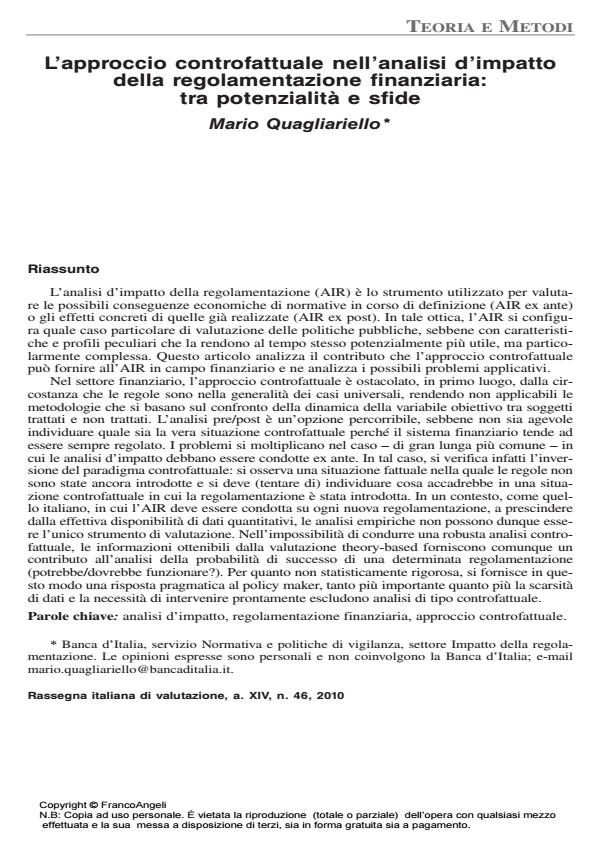L’approccio controfattuale nell’analisi d’impatto della regolamentazione finanziaria: tra potenzialità e sfide
Journal title RIV Rassegna Italiana di Valutazione
Author/s Mario Quagliarello
Publishing Year 2011 Issue 2010/46
Language Italian Pages 10 P. 59-68 File size 663 KB
DOI 10.3280/RIV2010-046005
DOI is like a bar code for intellectual property: to have more infomation
click here
Below, you can see the article first page
If you want to buy this article in PDF format, you can do it, following the instructions to buy download credits

FrancoAngeli is member of Publishers International Linking Association, Inc (PILA), a not-for-profit association which run the CrossRef service enabling links to and from online scholarly content.
Regulatory impact assessment (RIA) can be used either to understand the economic consequences of new pieces of regulation (ex ante RIA) or the real effects of past regulation (ex post RIA). In that respect, RIA is a special case of policy valuation, even though some of its features make it potentially more useful for decision-making, but also more complex to carry out. This article deals with these issues and analyses the contribution that the counterfactual approach can provide to RIA in the financial sector. It also discusses possible implementation problems. In the financial sector, the use of counterfactual approaches is more difficult since rules are universal, i.e., they are to be applied to all the intermediaries. This implies that methodologies that look at the differences between treated and non-treated firms are not appropriate. A pre/post analysis is certainly feasible in principle; however, the identification of a rule-free counterfactual is not easy since the financial sector is always subject to some form of regulation. Implementation problems are even more important when - and this is the most common scenario - RIA is to be carried out ex ante. In this case, the counterfactual paradigm is reversed: one can observe the factual - rules are not applied yet - and has to (try to) assess what would happen in the counterfactual, after the application of the new rules. In a framework, as in Italy, where RIA has to be carried out on any new regulation, empirical analyses may be unfeasible and qualitative information gathered through a theory-based approach may contribute to answer (perhaps) simpler questions on the expected outcome of the regulation (might it work? Should it work?). While lacking statistical accuracy, a qualitative assessment can still provide a pragmatic answer to the policy maker, particularly when the timing and urgency of the decisionmaking process - along with scarcity of data - leave out the option of counterfactual methods.
Keywords: Impact assessment, financial regulation, counterfactual approach
Mario Quagliarello, L’approccio controfattuale nell’analisi d’impatto della regolamentazione finanziaria: tra potenzialità e sfide in "RIV Rassegna Italiana di Valutazione" 46/2010, pp 59-68, DOI: 10.3280/RIV2010-046005